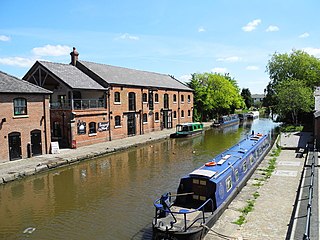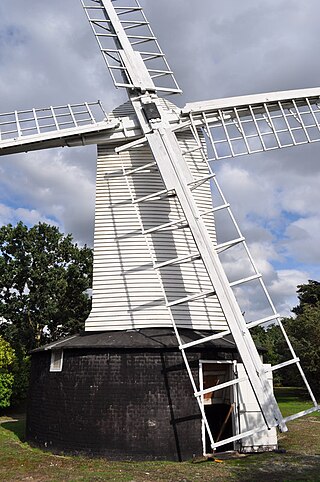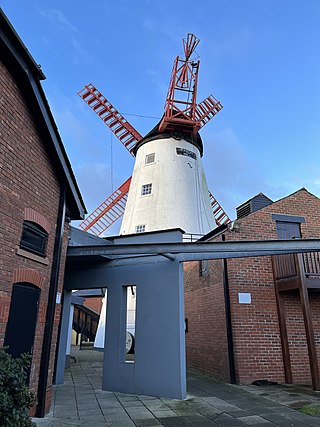
The Leeds and Liverpool Canal is a canal in Northern England, linking the cities of Leeds and Liverpool.

Toxteth is an inner-city area of Liverpool in the county of Merseyside.

Wavertree is a district of Liverpool, in the county of Merseyside, England. It is a ward of Liverpool City Council, and its population at the 2011 census was 14,772. Located to the south and east of the city centre, it is bordered by various districts and suburbs such as Allerton, Edge Hill, Fairfield, Mossley Hill, Old Swan, and Toxteth.

The Williamson Tunnels are a series of extensive subterranean excavations in the Edge Hill area of Liverpool, England. They are thought to have been created under the direction of tobacco merchant, landowner and philanthropist Joseph Williamson between 1810 and 1840. Although popularly described as "tunnels", the majority comprise brick or stone vaulting over excavations in the underlying sandstone. The purpose of the works remains unclear and remains a subject of heavy speculation; suggestions include commercial quarrying, a philanthropic desire to provide employment, and Williamson's own eccentric interests.

Burscough is a town and civil parish in the district of West Lancashire, Lancashire, England. The town is located approximately 14 miles (23 km) north-northeast of Liverpool and 13 miles (21 km) southwest of Preston. Its northern part is called Burscough Bridge, and was originally a separate settlement.

All Saints' Church, is in Childwall, Liverpool, England. It is recorded in the National Heritage List for England as a designated Grade I listed building, and is the only medieval church remaining in the Metropolitan borough of Liverpool. It is an active Anglican parish church in the diocese of Liverpool, the archdeaconry of Liverpool and the deanery of Liverpool South – Childwall.

Holy Trinity Church is in Church Road, Wavertree, Liverpool, Merseyside, England. It is an active Anglican parish church in the diocese of Liverpool, the archdeaconry of Liverpool, and the deanery of Toxteth and Wavertree. The church is recorded in the National Heritage List for England as a designated Grade II* listed building. It was described by John Betjeman as "Liverpool's best Georgian church".

Bidston Hill is 100 acres (0.40 km2) of heathland and woodland containing historic buildings and ancient rock carvings, on the Wirral Peninsula, near the Birkenhead suburb of Bidston, in Merseyside, England. With a peak of 231 feet (70 m), Bidston Hill is one of the highest points on the Wirral. The land was part of Sir Robert Vyner's estate and purchased by Birkenhead Corporation in 1894 for use by the public.

Wavertree Playground, known locally as The Mystery, is a public park and playground in the Wavertree area of Liverpool, England. It was one of the first purpose-built public playgrounds in the United Kingdom.
Liverpool in England has a significant number of public parks and gardens. The Register of Historic Parks and Gardens of Special Historic Interest in England describes the city's collection of Victorian parks as the "most important in the country". Liverpool has 10 listed parks and cemeteries, including two Grade I and five Grade II*, more than any other UK city except London. There are over 2,500 acres (10 km2) of parks and open spaces in the city.

Wavertree Botanic Garden and Park is a mid-19th century public park in Liverpool, England. Originally constructed as a private botanic garden, it was taken over by Liverpool Corporation in 1846 and expanded into a public park.

Holton Windmill is a Grade II listed post mill at Holton, Suffolk, England which has been preserved as a landmark.

The architecture of Liverpool is rooted in the city's development into a major port of the British Empire. It encompasses a variety of architectural styles of the past 300 years, while next to nothing remains of its medieval structures which would have dated back as far as the 13th century. Erected 1716–18, Bluecoat Chambers is supposed to be the oldest surviving building in central Liverpool.
Liverpool is a city and port in Merseyside, England, which contains many listed buildings. A listed building is a structure designated by English Heritage of being of architectural and/or of historical importance and, as such, is included in the National Heritage List for England. There are three grades of listing, according to the degree of importance of the structure. Grade I includes those buildings that are of "exceptional interest, sometimes considered to be internationally important"; the buildings in Grade II* are "particularly important buildings of more than special interest"; and those in Grade II are "nationally important and of special interest". Very few buildings are included in Grade I — only 2.5% of the total. Grade II* buildings represent 5.5% of the total, while the great majority, 92%, are included in Grade II.

Marsh Mill is an 18th-century tower windmill in Thornton, Lancashire, England. It was built in 1794 by Ralph Slater for local landowner Bold Hesketh. It functioned as a corn mill until the 1920s and has been fully restored. It is a good example of a complete English windmill and has been designated a Grade II* listed building.

Wavertree Lock-up is an 18th-century grade II listed village lock-up located in Wavertree, Liverpool, England.

The Burnley Embankment is an embankment carrying the Leeds and Liverpool Canal across the Calder and Brun valleys in Burnley, Lancashire. Also known as the Straight Mile, the embankment is 1,256 yards long and the canal runs up to 60 feet (18 m) above the valley floor. The structure was chosen as one of the original Seven Wonders of the Waterways, and has been awarded a Red Wheel by the Transport Trust.

Wavertree Town Hall is a municipal building in the High Street, Wavertree, Merseyside, England. The structure, which was once the offices of Wavertree local board of health, is a Grade II listed building.

















